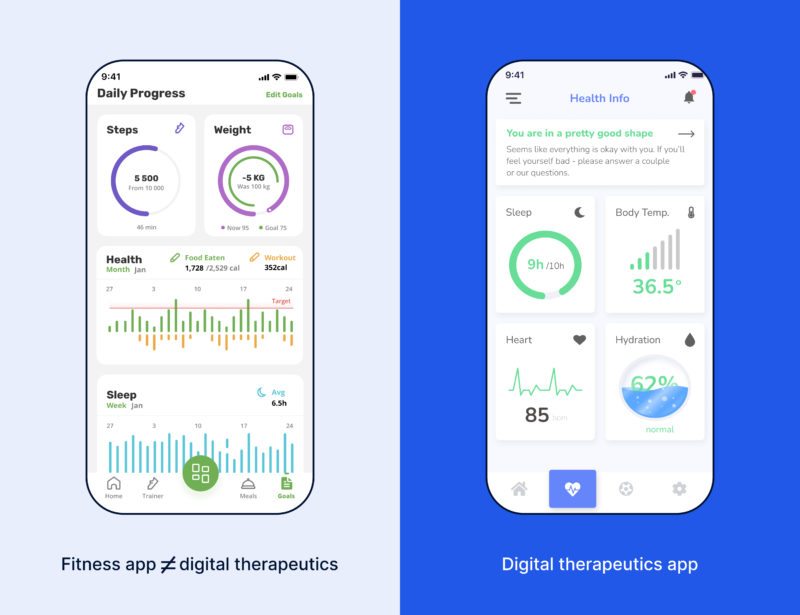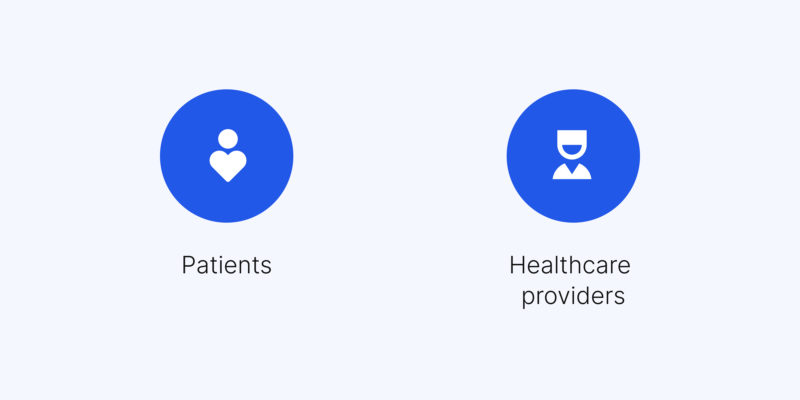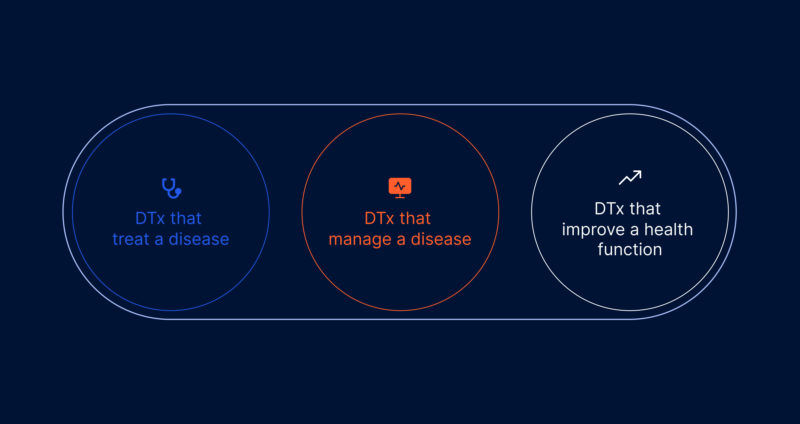
Contact us
Our team would love to hear from you.

Exciting developments are taking place in the realm of digital health right now. One of these is the step towards treating specific conditions digitally. A new and up-and-coming trend in digital health, known as digital therapeutics (DTx), is set to be a game-changer.
In this article, we will introduce the concept of digital therapeutics, discuss what benefits they can offer to patients and healthcare providers, and explain how they can lead to the best results.
To get straight to the point, digital therapeutics are an app that functions as a form of medicine. Such software incorporates scientific principles around a specific therapy to improve a patient’s condition while they use this app. With the help of technology and data, DTx allows personalizing care and achieving positive health outcomes.

Example of a digital therapy app
The term “DTx” was first coined in 2015, and it states that “Digital therapeutics are evidence-based behavioral treatments delivered online that can increase accessibility and effectiveness of healthcare.” According to the non-profit organization the Digital Therapeutics Alliance, “digital therapeutics deliver evidence-based therapeutic interventions to patients that are driven by high-quality software programs to prevent, manage, or treat a broad spectrum of physical, mental, and behavioral conditions.”
At first glance, digital therapeutics may resemble general health or wellness applications, but they are not. Health and wellness apps tend to perform only a limited number of functions, such as calorie tracking or steps counting. They mostly collect data without processing it. Digital therapeutics are advanced evidence-based software that, in the course of interventions, can evaluate or treat both mental and medical conditions.
Some of the diseases that digital therapeutics are used to treat include Attention Deficit Hyperactivity Disorder (ADHD), Post-traumatic Stress Disorder, Depression, and Schizophrenia. To further differentiate digital therapeutics from other solutions that might seem similar, let’s define the major characteristics of DTx:
Unlike over-the-counter health and wellness apps, prescription digital therapeutics (DTx) are typically positioned by developers of medications that require regulatory approval (FDA and other). As with all medications, it’s only possible to bring new DTx to market if you have the clinical evidence that they are safe and effective. Several digital therapeutics have already received regulatory approval in the EU and the USA, or are currently undergoing the approval process.
However, given that the concept of digital therapeutics is relatively new, no country has established a specific procedure to approve DTx.
In the USA, the home country of leading DTx developers, the FDA currently classifies DTx as software-as-a-medical-device (SaMD). Therefore, DTx have to undergo the same approval procedure as SaMD does. The DTx-related regulatory landscape in the EU is even more uneven. There is no unified regulation developed at the EU level, even though the European Commission is working on a common regulatory framework.
Currently, Germany, Italy, Belgium and France have implemented legal acts related to DTх.
The existing regulatory issues create numerous barriers for developers of DTx solutions, such as increased development costs, delays in bringing products to market, and difficulties with ensuring compliance. Recognizing the growing value of DTx solutions, the FDA and other regulators are working on developing a better approach to regulatory requirements needed for marketing DTx.
Some of the apps approved by the FDA include reSET and reSET-O for patients with opioid use disorder, Sleepio for patients with insomnia and anxiety, and Freespira for patients with panic attacks. At the moment, several new digital therapeutics are in clinical trials and expected to hit the markets.
There is a wide range of clinically proven therapeutic interventions that can be delivered through digital infrastructure. In some cases, DTх can replace therapies that healthcare practitioners have been using for 20-30 years.
In this regard, DTx can provide new perspectives, such as:

Perspectives and benefits of digital therapeutics
Visiting a specialist can be a daunting experience for many people. It’s much easier to pull out their phone from their back pocket and contact a doctor instead. After all, it saves patients a journey to the doctor’s office and creates incomparable advantages for certain categories of patients.
DTx allow people with mental disorders to train alone or with audio-only functions enabling them to maintain privacy and avoid the stigma associated with mental health issues. This greatly increases patient engagement with treatment.
The quality of face-to-face therapy depends, among other factors, on a doctor’s skills, experience, and individual characteristics that influence their behavior at work. This means that the quality of healthcare services can be variable. In contrast, the quality of digital therapy is controlled and consistently maintained by a software program.
Digital therapy is a connected therapy, and as a result, a therapist knows how their patients are doing. This information is incredibly valuable for improving therapy performance.
Also, underlying technologies like AI interpret input data provided by patients and adjust exercise and further treatment depending on their responses.
In addition to the points mentioned above, the popularization of DTx brings significant benefits to the following categories of stakeholders:

Advantages of DTx (digital therapeutics) for patients and healthcare providers
People want healthcare that is more accessible and personalized, but compared to many other fields, healthcare falls behind when it comes to improving customer experience. Therefore, the idea of having healthcare at their fingertips could seem very appealing to patients.
With digital therapeutics, individuals only pay for the care they actually receive, while bills for expensive office visits, unnecessary procedures or travel costs are eliminated.
As people have become accustomed to accessing their data related to online shopping or mobile banking, they are interested in having the same level of access to their healthcare information. By using an app that records and analyzes health metrics, patients can manage their health data, share it with healthcare providers, and receive personalized treatment plans at home.

Healthcare providers are currently working with vast amounts of data. By incorporating DTx into treatment programs, practitioners can benefit from using AI and machine learning, which enables proactive decision-making and real-time monitoring. This, in turn, reduces administrative burdens and instances of episodic care.
It is also worth mentioning that healthcare providers can stay in touch with patients who are managing symptoms or adhering to prescribed treatment on their own outside of the hospital by monitoring their condition and providing timely assistance.
Although digital therapeutics open new healthcare horizons, there are several barriers that prevent the adoption of this kind of therapy:
The Digital Therapeutic Alliance generally divides the digital therapeutics into three groups based on their purpose:

Use cases and examples of digital therapeutics
We will show you a few outstanding examples of digital therapeutics and such applications.
Currently, insomnia can be managed with the help of Cognitive Behavioral Therapy. However, this type of treatment requires trained specialists and is not easily available. The most commonly used alternative is sleeping peels, but they can also lead to dependency. Under these circumstances, Sleepio (digital therapeutic for insomnia) provides a safe and effective option for people suffering from insomnia. The solution is a program that features sessions with step-by-step guidance through proven techniques. The app allows users to set personal goals, keep a diary, and track their progress over time.
The purpose of this application in digital therapy in oncology is to help patients cope with cancer-related symptoms. When used as a supplement to a multidisciplinary cancer treatment plan, it can ease the burden of cancer. With the Oleena app (digital therapeutic for cancer symptoms), patients receive personalized recommendations depending on the severity of symptoms and can self-manage their condition. If the current condition is too severe for self-management, the patient is automatically connected to a care team. These care teams can then monitor their patients remotely.
Despite the growing number of patients struggling with different mental health conditions, there are still various treatment obstacles, such as missing treatment options or insufficient access to care. In response, a US company has launched the Feel DTx app to support those who struggle with Major Depressive Disorder or Generalized Anxiety Disorder. The app offers a well-structured 16-week programme based on Cognitive Behavioural Therapy, along with elements from neuroscience and biopsychology. Additionally, the app provides video and text support from certified health coaches.
Digital therapeutics for mental health and the app enables patients to receive help anytime, anywhere even if they can’t afford regular visits to the doctor’s office. This way, the use of the app can additionally help prevent complications associated with therapy interruptions.
The emergence of digital health and its subset digital therapeutics is reshaping the entire healthcare system. Regulatory-approved digital therapeutics are being used to treat a wide range of diseases and disorders, offering patients and healthcare providers new and advanced treatment options that can support or enhance current standards of care.
Looking for a reliable vendor of custom healthcare software solutions? At EffectiveSoft, we have a team of experts ready to help you with a project of any complexity. Just contact us to learn more.
Our team would love to hear from you.
Fill out the form to receive a consultation and explore how we can assist you and your business.
What happens next?